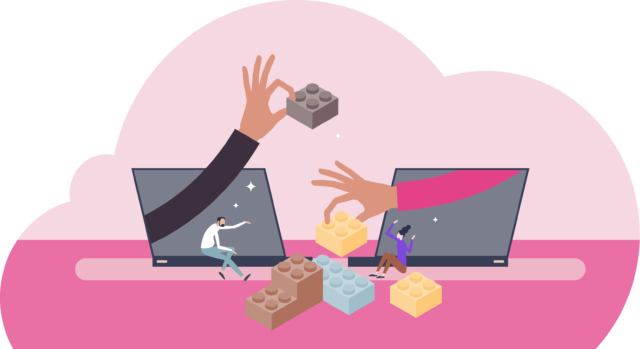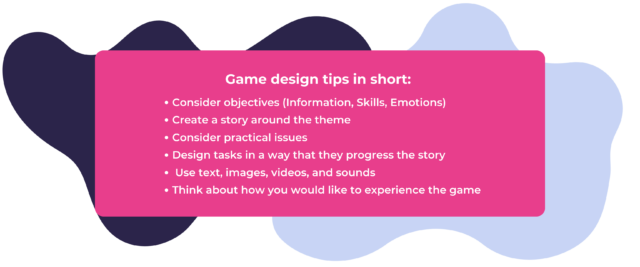Game Design – How to Design a Learning Game
Game Design – How to Design a Learning Game
Before rushing into actually producing the game, you must take some time to design it. The old saying applies here: well-planned is half done. So keep reading. You will see that designing a game can be both fun and insightful.
Read the article: What is gamification? Examples and how to benefit from it
Game design – Getting started
Now that you want to design a learning game, you are probably wondering how to get started. The answer is simple: start with your objectives. Of course, it is not quite that easy.
In addition to objectives, you need a clear theme, such as onboarding at work. A single game cannot include everything, so the idea must be specified. It is easier to design a game once the objectives and theme are clear in the mind.
Here, you can use the ISE formula. This refers to three simple goals that provide you with clear guidelines. You cannot fail in your game design when you consider these three things.
1. Information
It is important to think about what you want the players to learn when playing. This is the information level of the game. The question is: what information will the player learn? What is important to know?
It is good to think about this with reference to the theme. If the theme is onboarding, then you should consider what the employee needs to know when working. Gamification makes people better at internalizing information. It leaves a stronger memory imprint. The volume of information may be large, but it also needs to be somehow limited.
2. Skill
The greatness of gamification is that it provides a hands-on approach. It boosts learning and can bring about changes. That is why you should consider which skills you want the player to learn and which tasks can support this.
For example, when it comes to onboarding, you should think about the skills employees need at work. What should they learn to be able to handle their jobs easily? Once you know which skills they need, the game design can progress.
3. Emotion
Third, are emotional level objectives. What kinds of emotions do you want the player to have while playing? Are the desired emotions related to a specific topic or to the employer? Will the game aim to change opinions about something?
Emotions guide human behavior. They are easily remembered and extensive in scope. Games can create feelings of suspense, adventure, joy, astonishment, pleasure… You should also consider things that really interest us humans, such as status, competition, and rewards.
Read the article: Employee Onboarding – How to do it right

In game design, content comes first
Game design begins once the content has been planned out. Nobody has a magic button that can change thoughts or behavior. Good content can however teach, give insights, and initiate changes. This is why it should be carefully considered.
The contents of a learning game are comparable to designing curricula. You need to know what to teach the players. Only then can you begin to think about how to turn that into a game. Businesses and organizations with existing training materials have it easier.
In practice, game design means collecting content, questions, and ideas into a Word file or similar. The scope of the work depends entirely on whether there is existing material or if you need to start from scratch.
A business might for example already have an onboarding guide. If they wish to gamify onboarding, they can utilize the guide and see which parts of it they would like to use in the game. In this way, game design makes use of existing content.
The actual game design and implementation will not take very long (some days) if the content is ready and the game is simple. If you want to create a more challenging game with more gamified content, including plenty of video and audio material, tasks, and an insightful story, this might not apply.
In such cases, game design can take more time, even a few months, assuming that game design takes place alongside regular work tasks. Working on ideas together with colleagues is often quicker and more fun. Game design takes place first and foremost in the mind and in discussions with people.
Game design and practical issues
Naturally, game design requires consideration to be given to practical issues that can help build the game plan.
Some practical questions to consider:
- Will the game be played remotely or together?
- How many players will the game have?
- How long will the game last?
- How difficult will the game be?
- What kinds of tasks will the game include?
- How will audiovisual content be utilized?
- Can the contents of the game be used later or in different contexts?
The course of the game is affected by whether it is played remotely or together. If it is designed to be played together, you can use props. This is unlikely in the case when it comes to remote playing. The number of players also has an impact on design. You should consider whether the feedback is given face to face, in writing, or if there will be a separate debriefing for feedback.
The duration of the game is rarely known during the planning stage. This is why you should consider how much time can be used for playing. The difficulty of the game should be thought about while designing. Do you want a quick and easy game or one with some challenge?
Game tasks must be designed according to the target audience. You should employ audiovisual materials, like images, videos, and sounds, when designing tasks. These will make the game more interesting.
Videos and sounds do not need to be professional – you can make them yourself. The message is what matters, not how elaborately they are made. An ordinary cell phone suffices, resulting in an easily designed, implemented, and played game.
It is also worthwhile to consider if the content of the game can be used later in other contexts. The same game can work from one year to another, so it will not be a one-time project that gets left to collect dust.
Materials created during the game can be used for marketing or other purposes. One task can involve taking photographs, which can then be used on social media. In one case, a theme park needed a name for a new ride, so the game involved a task for coming up with one.
This should not of course be the primary goal, but it is smart to consider such things during design. In this way, you can get two birds with one stone.

Important elements of game design
Game design utilizes familiar gaming elements, such as levels, scores, and cooperation, which challenge the player to progress and develop. Many are sworn supporters of the code lock.
The code lock means locking a task behind three numbers, which must be arranged in the correct order. The task gives hints. Sometimes the hints are hidden in earlier tasks, so the player needs to go back.
Another popular task is taking pictures of post-it notes. The player can be asked for example to come up with inspiring quotes on post-it notes and take pictures of them.
“What unites people? Armies? Gold? Flags? Stories. There’s nothing in the world more powerful than a good story.
Nothing can stop it. No enemy can defeat it.”– Tyrion Lannister, Game of Thrones
Story-telling is one of if not the most impressive element of gamification. People have loved stories since the dawn of their time, gathering around the fire to hear them. There is something magical about a good story. It hooks you in.
And so do games. There must be a thread that runs through the game and takes the players from one task to another. At its simplest, it is a story around which the tasks are built. In the world of business, this could be for instance “My day in this profession”, where the player experiences different things during one day.

Conclusion
Game design is like putting together a puzzle. You need to have the whole picture before starting to work on the individual pieces.
The key is to think about objectives and about what people are genuinely interested in. Then the game can be designed, using familiar elements from other games. This creates the magic of the game that can be felt and that gets players excited.
Was this article useful? Share it on social media and let others benefit from game design insights too!